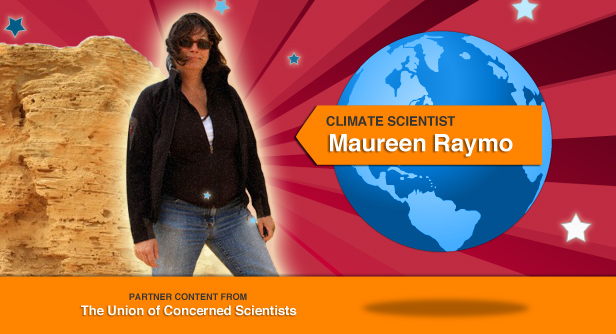Exactly how much did the sea level rise three million years ago? Okay. Probably not a question you’ve asked yourself lately. But the question and, more importantly, its answer are significant. They will help scientists understand how fast and how high our current sea levels are likely to rise as today’s global warming trend melts the remaining ice sheets in Greenland and Antarctica.
Fortunately, there are researchers wrestling with the problem. Chief among them is Maureen Raymo, a paleoclimatologist at Boston University. Raymo heads a multidisciplinary team that is spending its second summer digging for evidence in the desert of Western Australia.

Raymo is drawn to really big questions, a really good thing considering her line of work. In order to understand the connection between Australia’s prehistoric sea level and today’s climate conundrum, you have to be able to think on a grand geologic and planetary scale.
It turns out that global temperatures fluctuated long before humans began adding heat-trapping gases to the atmosphere. The fluctuations were the result of subtle, recurring shifts in the Earth’s orbit as it travels around the sun.
The tilt of the planet varies predictably on a 41,000-year cycle. More tilt means warmer summers and colder winters at high latitudes; less tilt means cooler summers and milder winters. Scientists believe this 41,000-year variation (known as the Milankovitch cycle), along with other variables — like the shape of Earth’s orbit and the seasonal timing of when Earth is closest to the sun — have influenced the advance and retreat of glaciers and thus the onset of ice ages as more or less solar radiation reaches Earth at mid-to-high latitudes.
Such observations from the complex field of orbital dynamics have helped scientists like Raymo identify the cyclic changes in the Earth’s climate. But these “orbital forcings” are only a piece of the climate puzzle. The Earth’s geologic history also plays a role.
Three million years ago, during what is known as the mid-Pliocene climate optimum, Earth was a much warmer place. In fact, this period marked the most recent time during which the climate was consistently warmer than it is today for an extended period. During the mid-Pliocene climate optimum, global temperatures were as much as 5.4 degrees F above today’s averages. As a graduate student, Raymo proposed that this warmth was due to higher levels of carbon dioxide in the atmosphere at the time, a hypothesis that is still being tested today.
Scientists are not sure how high the sea level was during the mid-Pliocene climate optimum. Some past research suggests that it was just 15 feet higher than it is today; other research puts it as much as 100 feet higher. Raymo hopes to significantly narrow this gap. “If we can determine exactly where the shoreline was three million years ago,” she says, “we can tell a lot about how much ice remained in Greenland and Antarctica during this warm period.”
To map the ancient shoreline, Raymo and her team work their way inland from the Australian coast in search of fossilized coral reefs and other evidence that the land was once covered by ocean. “Each time you add a data point,” Raymo says, “you help to calibrate existing climate models in an important way and build a broader knowledge base for future experiments.”
Raymo is quick to add that uncertainty about a specific question such as the maximum sea level in the Pliocene Epoch should not be equated with uncertainty about today’s overall global warming trend. Climate-change skeptics who jump on uncertainties to dispute global warming, “completely miss the point,” says Raymo. “Science is always evolving intellectually, processing and incorporating the latest information. Scientists always want more knowledge. They always say ‘I want to try to test out that new idea.'”
“Even so,” Raymo says, “everything I’ve learned about the dynamism of the planet’s climate places me, like most all of my colleagues, strongly in the camp that says we need to take preventive action to keep the planet from warming further. I am extremely concerned that we’ve made such large changes in the composition of our atmosphere with so little understanding of the consequences. The path we are on is completely anomalous to anything that has gone before.”
Paleoclimatologists like Raymo focus on vast stretches of geological time, studying variations in the earth’s climate over the course of the planet’s history, gleaning evidence from a variety of sources to track which parts of the planet were once covered by glaciers or oceans. They see geologic evidence of glaciers in shifts of the terrain and in the rocks and other material the glaciers left behind; they find chemical evidence of oceans in variations in the ratios of isotopes in sedimentary rocks.
The tricky part, of course, is to figure out how to use the hard evidence available today to draw conclusions about past climate. It is a part of her job that Raymo particularly enjoys. “I love thinking ‘How does the Earth work?'” she says. “I have always felt a natural ability to think about the planet, almost as though I were looking down on it from above.”
This kind of big picture thinking runs in Raymo’s family. Her father, Chet Raymo, is a science writer well known for his musings on grand-scale topics in the natural world. But when asked how she got interested in science, Raymo credits Jacques Cousteau. At age seven, she was captivated by one of the French undersea explorer’s television programs. “From then on I decided I wanted to be an oceanographer,” she says. That passion stayed with her all the way to college, when she was seduced anew by the cutting-edge climate research of geologists John Imbrie and William Ruddiman, who became her mentors.
In her research, Raymo tackles many aspects of paleoclimate and orbital forcings. In 2006, she hypothesized, in the journal Science, about why the 41,000 year Milankovitch cycle appears less pronounced over the past 500,000 years. “It was a question that I had literally been thinking about since graduate school some two decades earlier,” she says. No one knows the answer yet. But Raymo’s theory — that ice growth at one pole occurs simultaneously with ice decay at the other, thereby canceling out the signal of ice volume change in global climate records — has sparked a great deal of new research and debate. If she’s right, then earth’s climate is even more dynamic and complex, especially in the area of the Antarctic ice sheet.
While orbital forcings offer a fascinating window into the historical mechanisms of climate variation, Raymo emphasizes that they are overshadowed today by human-driven effects on the climate. “People sometimes ask me: ‘When will the next ice age be?'” she says. “The answer is that I’m pretty sure we have already prevented it. Like it or not, we are now the main drivers of the climate, even though so far we’ve been doing it completely by accident.”
This is the eighth installment of America’s Climate Scientists: A series from the Union of Concerned Scientists. Click here to read all the climate scientist profiles.
The Union of Concerned Scientists is currently leading a campaign to elevate the voices of climate scientists and educate the public about the overwhelming scientific evidence for human-caused global warming. Learn how you can get involved at www.ucsusa.org/evidence.



